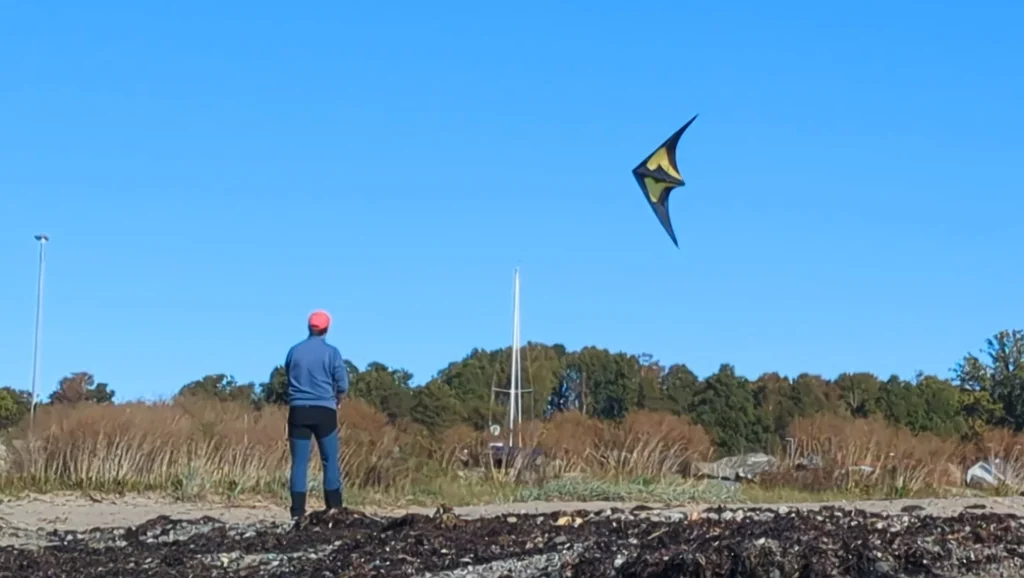Among the most critical components of this experience are the flying lines. These slender yet robust cords are what connect you to your kite, enabling you to execute precise maneuvers, tricks, and flight patterns. This article explores the importance of line characteristics—especially their length and elasticity—and discusses the pros and cons of shorter and longer flying lines.
The Importance of Equal Line Lengths
For sport kite flying, it is crucial that all lines are exactly the same length! Even the smallest discrepancy can disrupt your control and the kite’s responsiveness. Uneven lines result in one side of the kite being tighter than the other, causing it to pull unevenly, veer off-course, or struggle to execute tricks symmetrically.
How to Ensure Equal Lengths:
- Initial Matching: When purchasing or cutting lines, ensure all are of identical length using precise measuring tools.
- Regular Checks: Over time, lines may stretch or wear unevenly. Periodically check them by anchoring both ends and ensuring they remain perfectly aligned.
- Adjustments: If you notice uneven lengths, trim or adjust as necessary. Many sport kite enthusiasts carry splicing tools for on-the-spot fixes.
Here is a link to an on-field-quick-fix line length equalizer!
—
Low Elasticity: Why It Matters
Another critical factor is the elasticity of the flying lines. For sport kites, low-stretch lines are ideal because they provide immediate and precise feedback. Elasticity can create a lag between your input and the kite’s reaction, which reduces accuracy and control.
Preferred Line Materials:
- Dyneema/Spectra: These high-performance synthetic fibers are renowned for their strength, light weight, and minimal stretch.
- Polyester: While slightly more elastic than Dyneema, it’s more affordable and suitable for casual flyers.
Line Length Considerations

The length of your flying lines plays a significant role in how your kite behaves. Choosing the right length depends on your skill level, flying conditions, and the type of tricks or maneuvers you want to perform.
Short Lines (15–20 meters): Pros and Cons
Shorter lines are popular for fast and furious trick flying and in areas with limited space.
Pros:
- Quick Response: Short lines translate your inputs to the kite almost instantly, making them ideal for high-speed tricks.
- Tighter Turns: The kite can execute sharper, more precise turns and loops.
- Portability: Shorter lines are easier to manage, transport, and set up.
Cons:
- Reduced Flight Window: The kite has a smaller area to maneuver in, limiting expansive tricks and patterns and less slack for errors.
- Steeper Learning Curve: Beginners may find the rapid response challenging to control.
- More Sensitive to Wind Variations: Short lines make kites more reactive to sudden gusts or turbulence.
Long Lines (30–40 meters): Pros and Cons

Longer lines are favored for freestyle flying, flowing, graceful maneuvers, team flying and flying in large open spaces.
Pros:
- Larger Flight Window: The kite can cover more ground, allowing for expansive tricks and smoother movements and more time to correct any error.
- More Stable Flying: Longer lines buffer sudden wind changes, providing a steadier experience.
- Ideal for Team Flying: In group routines, longer lines reduce the risk of entanglement and allow for coordinated movements in a larger wind window.
Cons:
- Slower Response: Inputs take slightly longer to reach the kite, which may affect precise trick execution.
- Increased Drag: Longer lines create more air resistance, which can reduce kite speed in light wind conditions.
- Challenging Setup: Managing longer lines takes more time and space, and tangles can be harder to resolve.
Choosing the Right Line Length
Your ideal line length depends on several factors:
- Skill Level: Beginners might start with medium-length lines (20–25 meters) for a balance of control and maneuverability.
- Flying Location: Shorter lines suit confined areas, while longer lines are better for open fields or beaches.
- Weather Conditions: In low wind, shorter lines reduce drag, whereas longer lines work better in steady, moderate winds.
- Flying Style: Trick-heavy flyers may prefer shorter lines for precision, while those focused on choreographed routines or casual flying might favor longer ones.
Conclusion

In sport kite flying, the quality and characteristics of your lines can make or break your experience. Always ensure your lines are of equal length and opt for low-stretch materials to maintain control and precision. Whether you choose short or long lines depends on your preferences, skills, and conditions, but understanding the trade-offs will help you make an informed decision.
With the right lines and preparation, your kite flying sessions will be a seamless blend of art, skill, and exhilaration.
—
This article is written with the help of AI.




